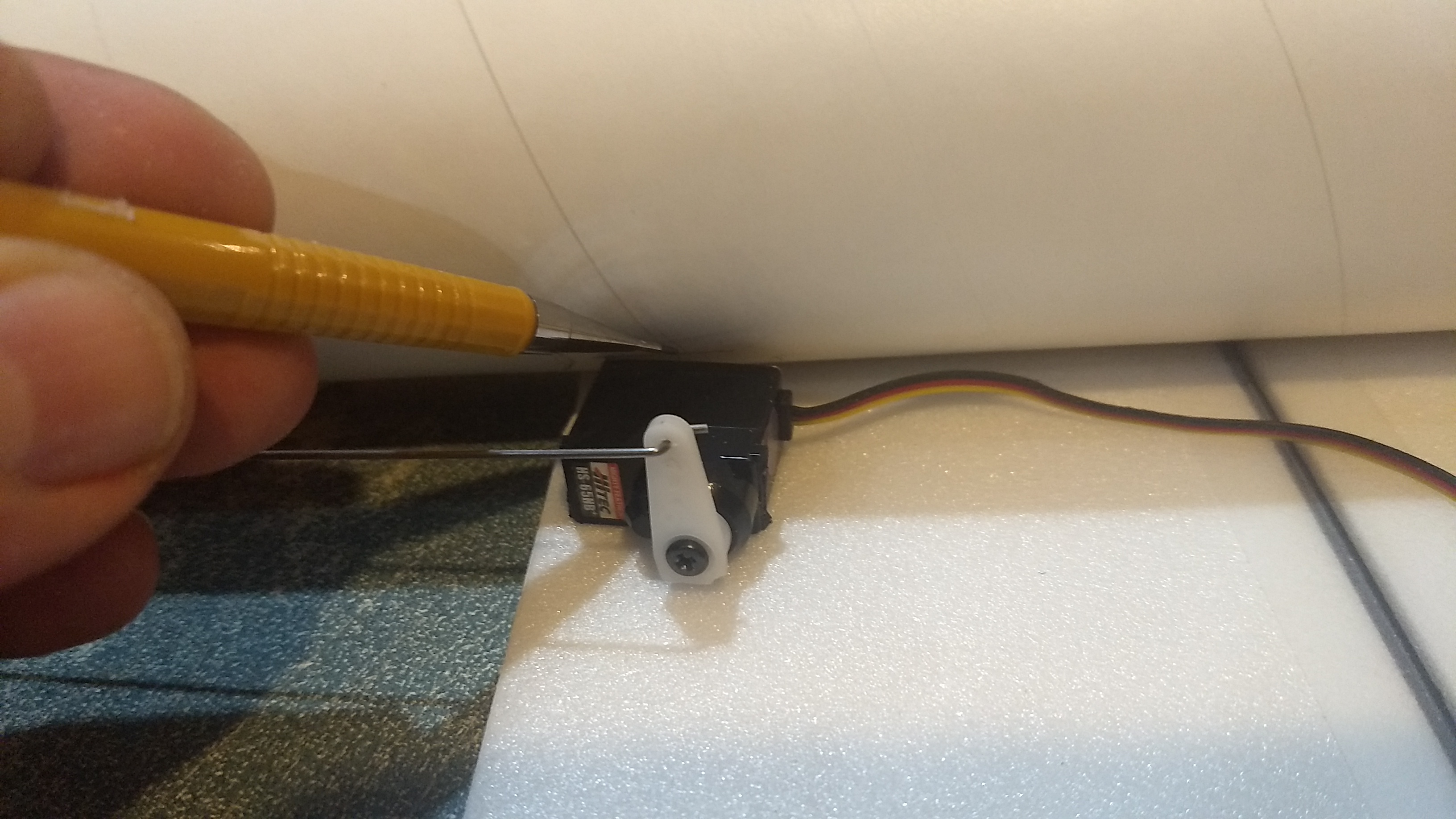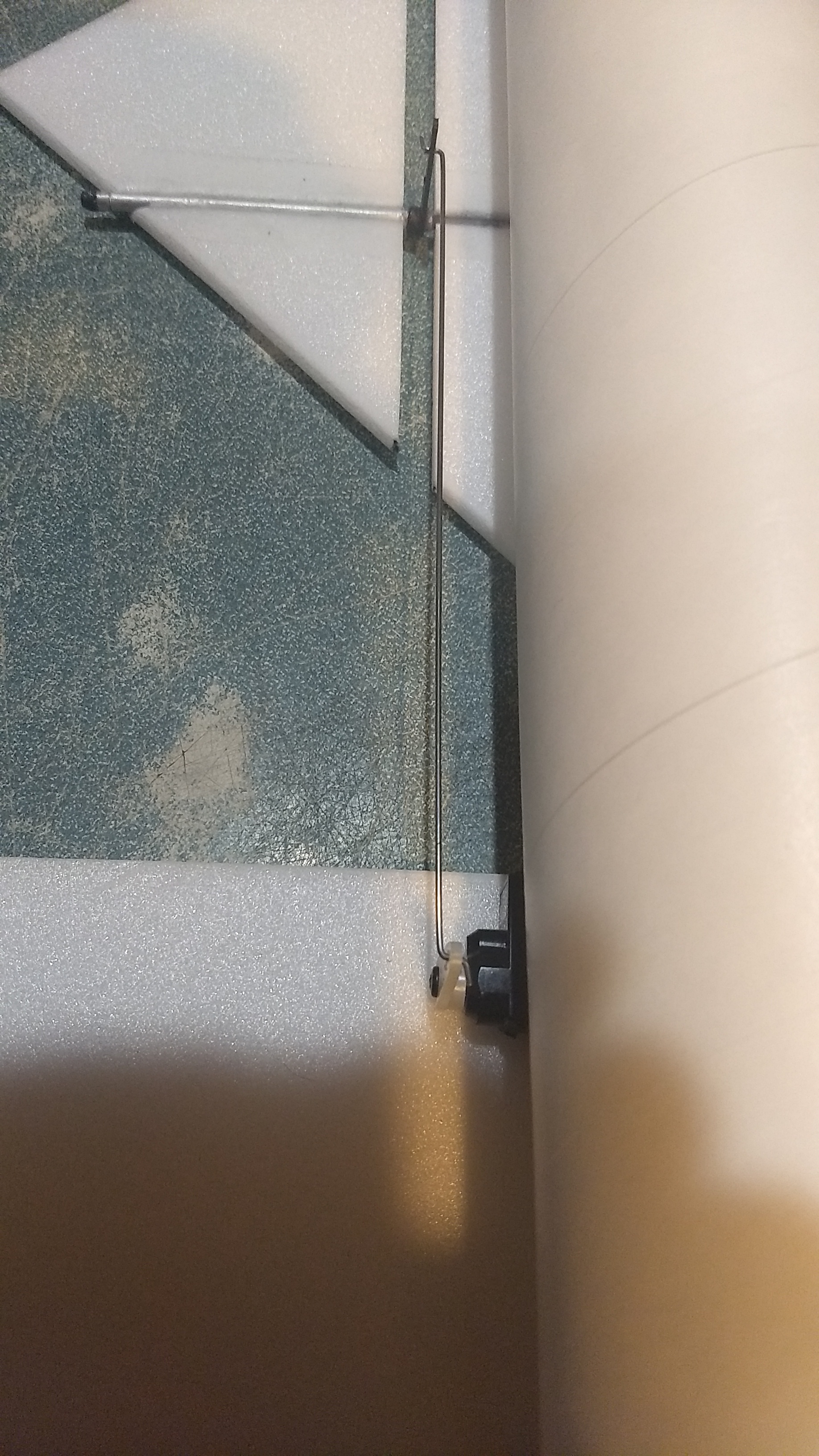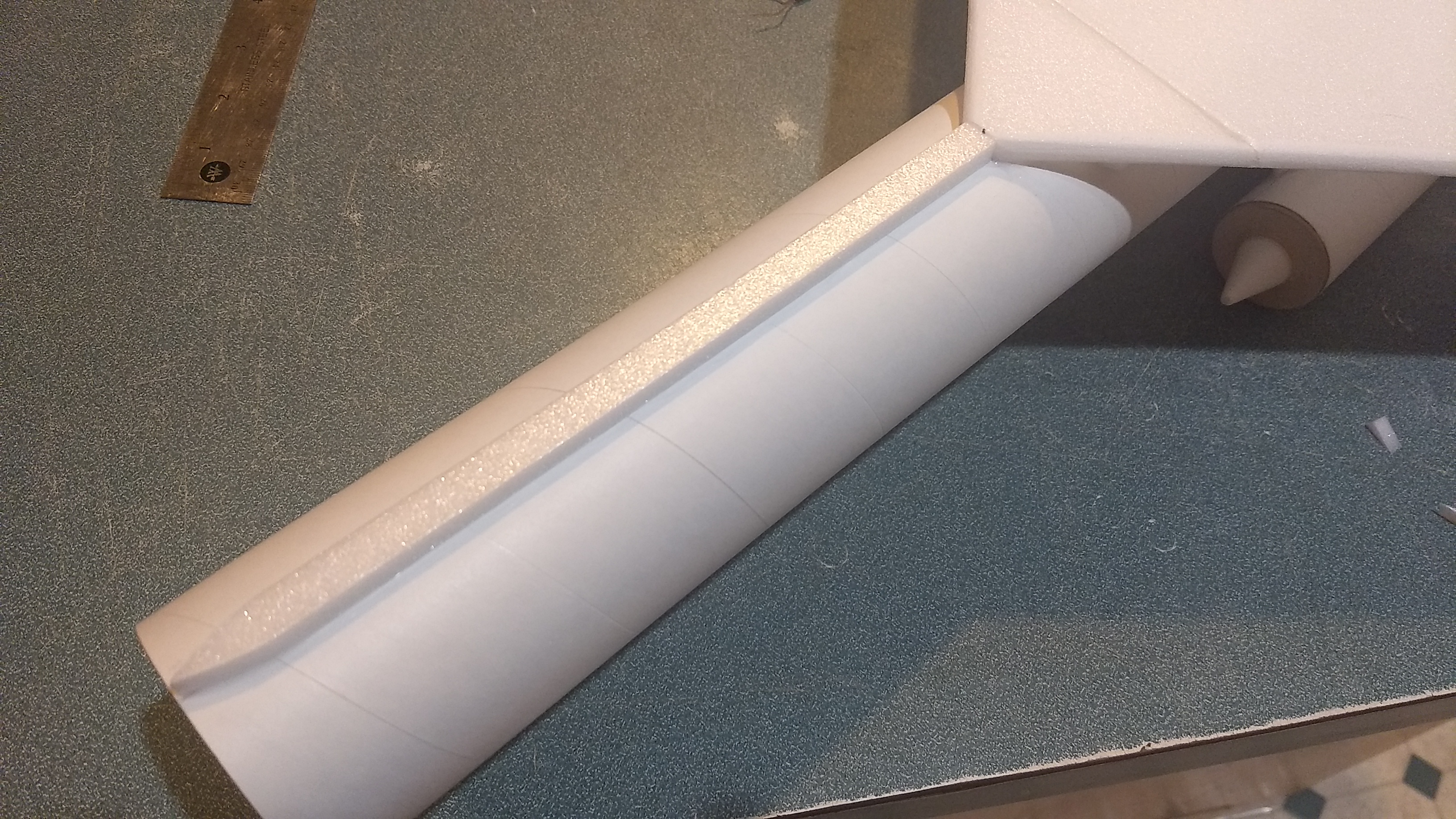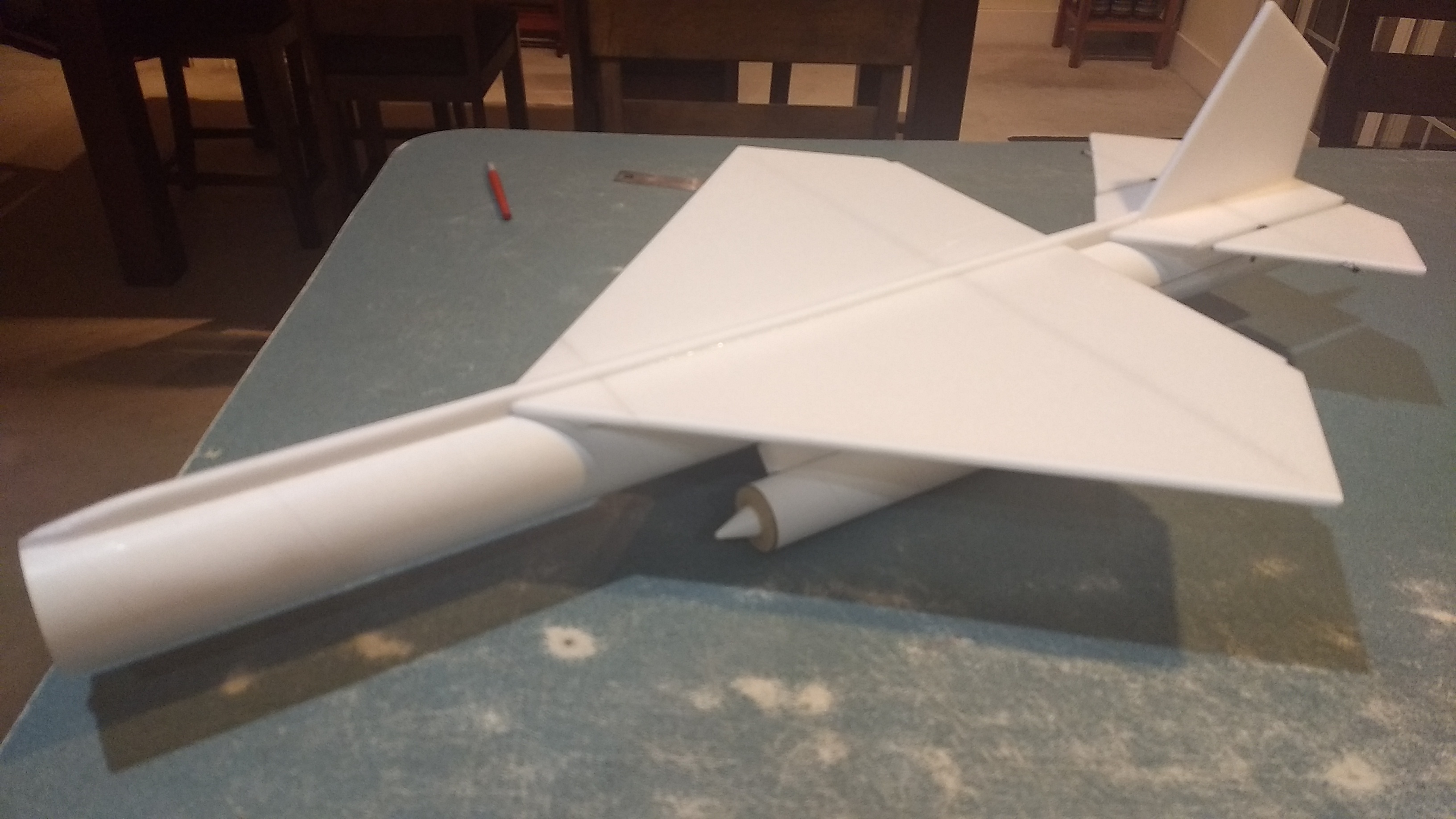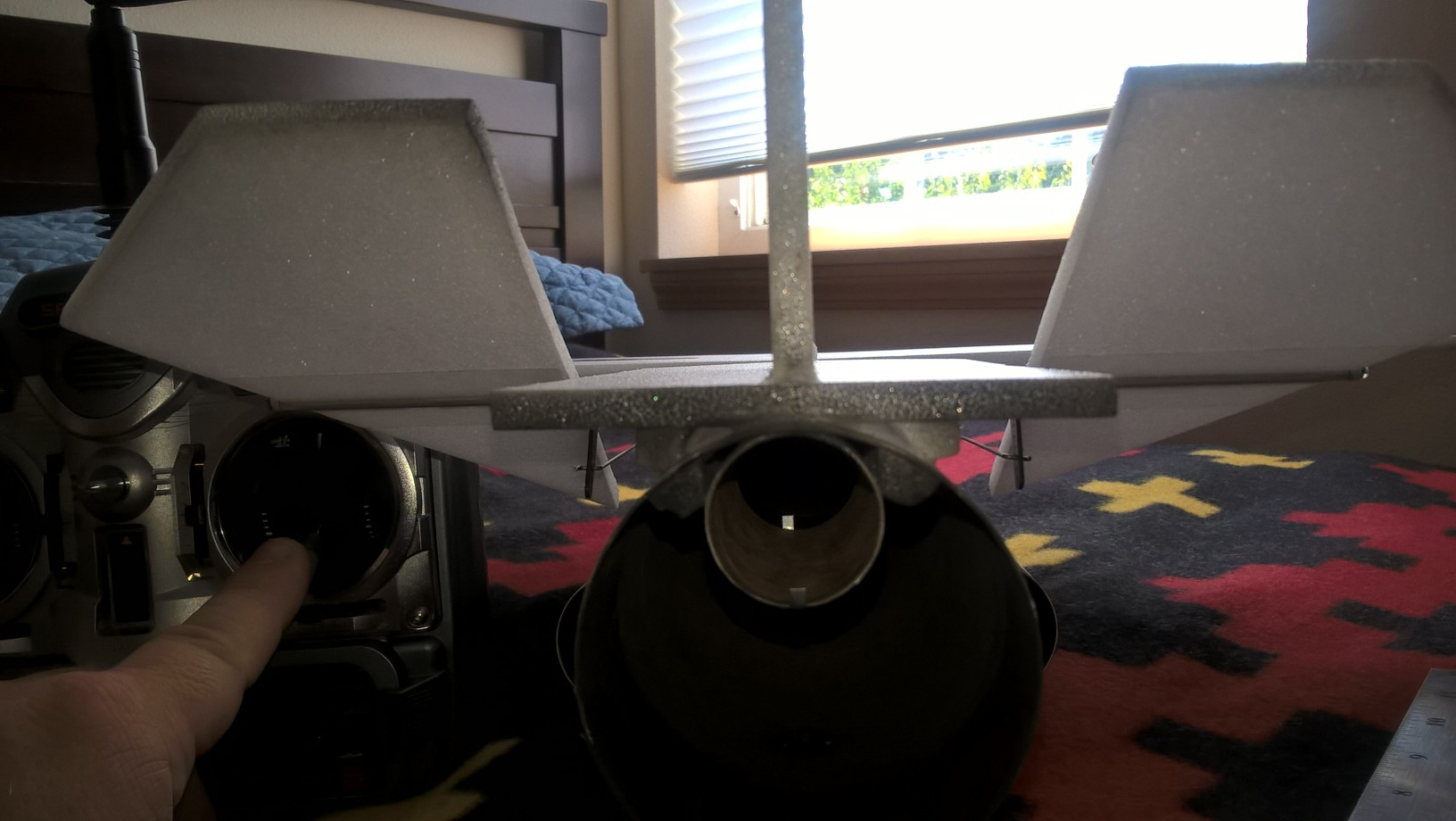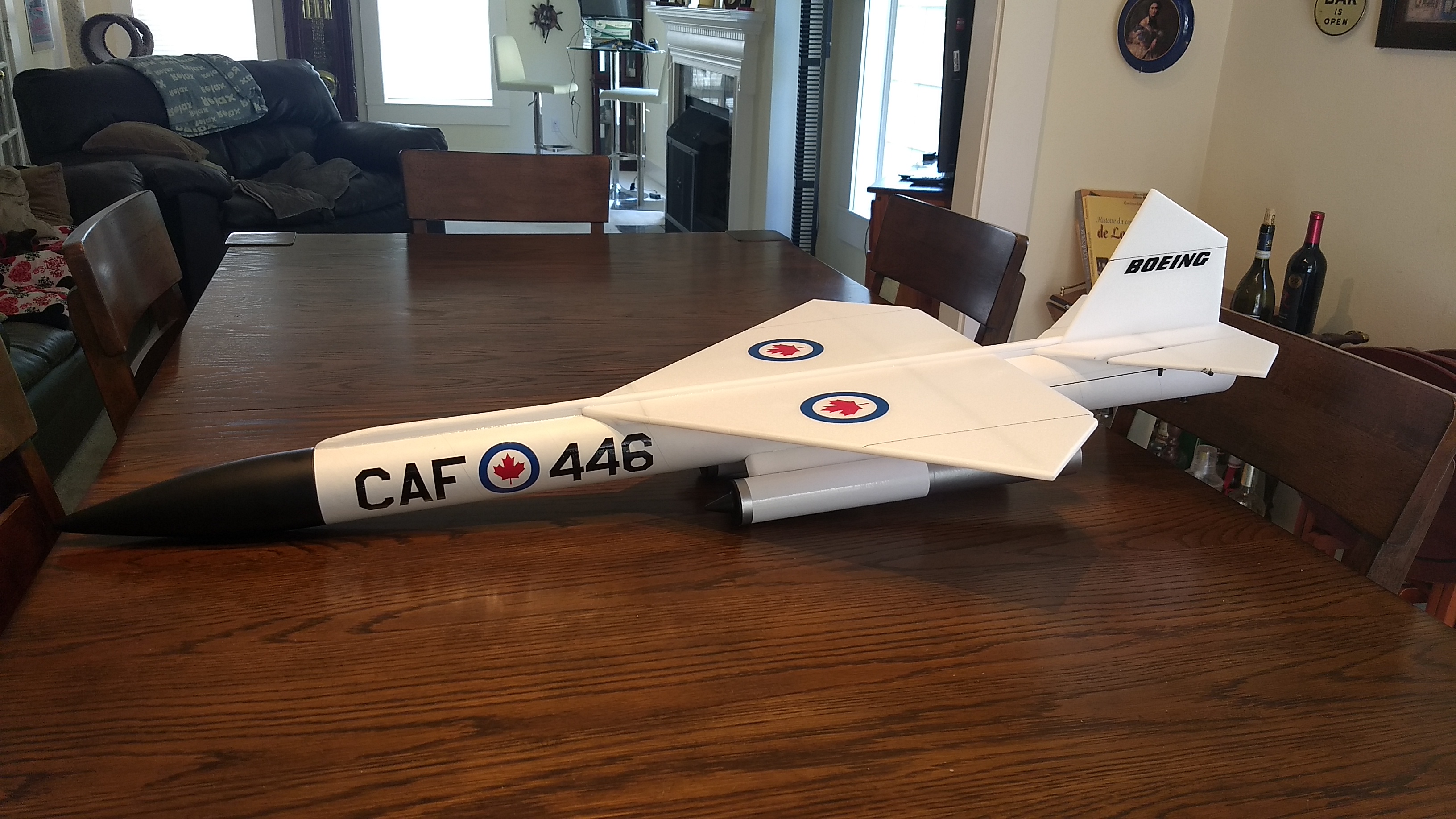
These kits are for the advanced rc rocket glider flyer. Wing loading and weight is higher than my other kits. This model requires it to be boosted on a faster E-12RC aerotech reload using the 24/40 RMS RC casing I sell, due to the heavier weight. Standard Aerotech 24/40 E-11-3J using the normal non RC 24/40 casing is also ok if you leave out the ejection charge. Landing on the ramjet pods requires more finesse on landing to avoid damage to the model. Glide times are correspondingly shorter, typically around 30 seconds. It is 42″ long, 2.6″ diameter, 17 oz rtf and has a 21″ wingspan. It is approximately the same size as the madcow 2.6″ kit but approximately 1/3 of the rtf weight. High quality cut vinyl decals are available from Stickershock23 HERE
Please refer to the notes on items needed for completion and flying, then read the instructions completely before starting assembly. The assembly photos are for general reference but may not include every step in the manual.
CG location for rocket flight 9 1/8″ forward from the TE of the wing
Welcome to the world of rocket boosted radio control gliders. This is not a model for a novice RC pilot, but anyone who is comfortable with RC flying of a medium speed model should be fine. Read through the instructions, look at the photos and be sure you understand the step before commiting to cutting or glue.
Instructions:
Identify all pieces, the kit should contain:
1 wing taped together
2 pushrods
1 Vertical Stabilizer
1 horizontal stab assembly.
2 long Foam wing reinforcing strips
2 medium Foam horizontal tail reinforcing strips
2 short foam motor mount reinforcing strips
2 Body Tubes
2 ply ramjet intake disks
2 foam ramjet intake disks
paper cone patterns
2 ramjet standoffs
2 ramjet tubes
1 long 3/8″ wide foam strip for the top conduit
1 short 3/8″ wide foam strip for the lower conduit
Motor mount
Velcro(for battery and rx/bec attachment)
2 Rail buttons/t-nuts
Lead weight
Spare depron
Notes before starting:
Reference to CA+ means foam safe CA+, this is the only glue to use on this model, do not use epoxy, hot glue etc. normal CA+ will melt the foam! Normally you need to use accelerator to get the CA to set on the foam since there is nothing for it to soak into and activate.
You may use 220-320 grit sandpaper and a sanding block to slightly round the edges of the foam if you prefer that look. It will not markedly impact the flight performance either way. Be very careful and use a light touch, it is very easy to catch the foam on the edge of the paper and tear the foam. Do any sanding before assembly.
Weight is critical and the model is designed for the thrust and flight loads. Weight in the rear end is bad and will require additional weight in the front of the model. Do not use epoxy, it is not necessary and adds weight. I do not recommend painting the model as it already has a high wing loading, and paint will add 1/2 to 3/4 ounce minimum, mostly in the tail which requires even more nose weight. Chose a white scheme in usaf or canada markings.
Assembly:
- Unfold the wing and glue the tape joint using CA+ and accelerator, make sure it is flat
- Body Tubes. One of the tubes will have rail buttons installed and will have a line inside the tube on one end, that is the rear tube and the inside line is for the motor tube alignment.
- Insert the two pushrods into the the third hole from the outboard end of the control horns on the horizintal stab assembly. Do this from the inboard side of the horn, do it now because it is difficult to do this once the stab is glued to the tube. You will need to twist the pushrod to get it to go into the hole, be careful and don’t poke your finger, go slowly so that it fits snugly.
- Glue the horizontal stab assembly to the top of the rear body tube with the rear of the stab flush with the end of the tube. Use the alignment line on the tube to make sure it is straight.
- Glue the motor tube at the top of the body tube right underneath the horizontal stab and aligned with the end of the body tube. Use the alignment lines on the body tube and motor mount. The model is upside down now so it will be the at the bottom of the tube in this orientation. Make sure the motor tube is aligned straight with the body tube. Look from the front of the body tube and make sure the motor tube is not offset. There are no centering rings needed or desired because you may need to reach wiring or weight at the rear of the model. The motor tube hook is only taped on one side, you want to be sure you don’t glue to the tape or hook, this is done so that you can glue the paper motor tube directly to the body tube without the tape in the way.
- Glue the two short reinforcing strips on either side of the motor tube and add a fillet of CA+ to help support the motor tube.
- Glue the two medium reinforcing strips on either side of the horizontal stab/body tube joint and add a small CA fillet. This provides extra strength for the joint. Don’t push the strips in too hard or it can rotate the tube slightly.
- Glue the front body tube to the rear assembly, making sure to keep the line on the top of the tubes aligned, this is used to align the wing and conduits and to keep the ramjet pod holes aligned..
- Make a line 1.5″ in front of the LE of the horizontal stabilizer. This will be the TE of the wing.
- Lay the wing upside down on a flat surface. Using CA+ foam safe glue, glue the body tube to the wing. Use the pencil marks on the body tube as a guide to keep it straight. Make sure the rear of the wing is 1.5″ forward of the front of the horizontal stabilizer assembly.
Apply CA+ foam safe glue to one of the reinforcing strips and glue one on each side of the wing/body tube joint. This piece is there to give more gluing surface to the wing/body tube. If you push in too hard on these strips it can cause the body tube to rotate slightly, so pay attention. Once they are in place put a fillet of CA+ on both the wing and body tube joints. - Connect a servo to each pushrod. The servos will be installed so that servo arm is facing the wingtip and the electric wire is facing forward. then Connect the servos to the receiver and turn on the radio. Make sure the servo arms are centered and pointing straight up.
- Mark on the body tube where the servo pocket will need to be cut. the pocket needs to just be deep enough to allow the pushrod to go straight to the control arm and not interfere with the control surface tip, see picture.
- Attach a 24″ servo extension to each servo, and route the servo wires into the body tube and to the front. Then apply glue to the bottom of the servo and glue it in place in the pocket against the bottom of the wing.
- Glue a standoff to each ramjet tube using the holes provided, try to keep the standoff perpendicular to the tube. Be very careful, you may need to open the slots up slightly so you do not have to push too hard on the standoff and crack the foam, use a screwdriver and wiggle side to side and keep checking to it will slide in place, then glue. Apply a fillet of glue on each side of the standoff.
- Glue a foam disk onto each of the ply disks. Test fit this assembly into the front of the ramjet. The front is the part with the coupler glued in place. The foam is a crush fit and makes a shoulder to center the ply plate. Twist and insert slowly till the ply plate is flush with the end of the tube, then remove and glue in place.
- Cut out two of the paper cones. Roll the paper over a table top to curve it and then glue the tab to make a cone. Reinforce the inside and outside with CA glue to harden it and then glue to the front of each ramjet ply plate.
- Before the next step if you are using the stickershock decals it is much easier to apply the white/silver to the ramjets before attaching to the main body.
- Paint the ramjet intake black or white.
- Apply the white wrap to the front of the ramjet, start with the vinyl lined up against one of the standoffs and gently wrap it around the tube trying to keep the front edge aligned.
- Apply the 3/8″ silver strip to the front of the ramjet, wrap it around the front edge.
- Apply the silver wrap to the rear of ramjet tube, it will overlap the white about 1/4″.
- Glue each ramjet pod into the fuse using the holes provided. As before make sure you open up the slots so that the carbon tabs will insert without undue force, use a small screwdriver etc to help. Apply a fillet of glue on each side of the ramjet standoff at the body tube joint.
- Glue the vertical stab to the horizontal stab using the tab. Make sure it is 90 degrees to the wing, is straight and reinforce with a slight fillet.
- Cut a strip of the short 3/8″ wide foam conduit to fit between the TE of the wing and the front of the stab. Glue it in place.
- Use the remaining short strip of 3/8″ wide foam to go from the front of the the wing to the front of the body tube. You will need to sand/cut the front to a pointed shape.
- Using the long 3/8″ wide strip cut/fit it to to the top of the conduit strip and the top of the wing. The front and rear should be sanded/cut to a pointed shape. Carefully sand the top of these conduit pieces round then glue them in place. It’s hard to sand them to a rounded shape after gluing them in place. Take your time.
- The basic construction is now complete.
Radio Installation
Note: Your radio needs to be configured for Delta mixing, this means that the servo arms will move the same direction during elevator stick movement and opposite for aileron stick movement. Connect your servos to the receiver one in the aileron connection and one on the elevator connection and apply power. Use a servo arm at least 9/16” long and with holes small enough that there won’t be slop with the pushrod wire when installed. I use the hole furthest out on the servo arm, to maximize movement. On some servos there are a long two-ended servo arm, you can trim off one end if needed to get sufficient length. Zero out any trim settings on the transmitter.
- Look at the model from the rear. Moving the transmitter stick back(up elevator) should move both elevons up. Moving the transmitter stick to the right should move the right elevon up and the left elevon down. If you can’t get the servo reversing to give you the right polarity try swapping aileron/elevator inputs to the receiver. If that is correct, continue..
- Make sure the control surfaces are centered. Now measure the control surface movement. Full elevator and aileron movement should be 1.5-1.75” in each direction. Since the model will be nose heavy, extra elevator movement helps to give sufficient authority during glide. For boost, due to the extra throw it may be twitchy, you can consider dual rate for boost to help tone this down.
- If you have a flap/elevator mix you can program up elevator to a switch setting. The model needs approximately 5/8” of up elevon during glide. If you can’t set the up elevator trim to a switch on your radio you’ll have to manually put in boost and glide trim which is hard to do while flying the model. My model required a tiny bit of up trim for a straight boost but try neutral controls for the first flight.
- Use the included Velcro to attach the receiver as far into the nose cone as possible. Use velcro to attach the battery as far forward into the nose cone as possible still allowing you to plug and unplug it into the receiver connector wire.
- Insert your heaviest loaded rocket motor into the motor mount
- Support the model at the balance point indicated for boost. I use two pencils with the eraser pointed up and held in place with a small hand vice. Place the model right side up on the pencil erasers on the balance point indicated in the kit spec sheet. Use the included lead weight as needed and as far forward in the end of the nose cone as possible to balance it. You can secure the weight with CA to hold it in place once you determine the correct amount.
- Do not try to fly the model with it balancing it behind this point. The adage is, a nose heavy model flies poorly, a tail heavy model flies once.
- I’d recommend placing some packing tape or trim vinyl/monokote on the bottom front of each ramjet tube to help avoid scuffing when landing. The decal sets from stockershock.com contain a silver wrap for the rear of the ramjet and a white wrap for the front of the ramjet.
- The decal sets are designed for a white body/wing with a brown, grey or black nose cone and you can paint the nose cone with any type of paint. The ramjet intakes may be hand painted with silver or black or white as desired. The decals include a 2.5″ by 4″ silver square which goes on the bottom rear of the body tube, and two 2.5″ by 5″ squares in silver which go on the trailing edge bottom of each wing. These simulate the stainless areas that were designed to protect against the ramjet heat.
- Re-install the receiver and battery
Flying: See the Instruction/Information link at the top for flying instructions Be ready on the first few flights to keep the model straight till you have the trims set perfectly for boost and glide.
- Unfold wing and glue taped joint
- Make sure wing stays flat
- Glue horizontal stab to the top of the body tube, note the inside line for the motor tube.
- Glue reinforcing strips on each side of the horiz stab.
- Glue the motor tube in place on the alignment line, then glue reinforcing strips on each side(not shown)
- Glue Reinforcing strips on either side of the motor tube.
- Glue the two body tubes together keeping the alignment arrow aligned, then glue the wing in place on the line marked on the body tube making sure it is 1.5″ ahead of the tip of the horizontal stab. DO NOT glue the wing gusset in place at this time.
- Attach servo to pushrod then mark body tube where you will need to cut a pocket to recess the servo.
- cut the recess, you just need the servo to sit deep enough to have a straight pushrod line to the control arm.
- Install servo, glue to the wing.
- Top view showing desired straight pushrod route that won’t interfer with the control surface tip.
- Glue the wing in place and dd reinforcing strips on either side of the wing joing ahead of the servo.
- Test fit the standoff into each ramjet tube.
- Glue the standoff to the ramjet tube.
- The two ramjet cap pieces
- Glue the foam disk onto the ply plate
- Slowly twist and insert the end cap into the front of the ramjet pod(the end with the coupler glued flush with the front. The ply plate will stop when flush with the end of the tube.
- Remove the cap, then add glue into the end and glue the cap in place.
- Make two cones from the paper templates and glue in place in the front of each ramjet plate, reinforce with ca.
- Glue the Ramjets in place and fillet both sides
- Add the vertical stab
- Add rear conduit filler
- Shape then add forward conduit lower portion.
- Front top conduit.
- rear top conduit
- Fitting the foam conduit at the rear
- Glue conduit on top of wing and sand to shape if needed.
- Completed airframe
- Left aileron throw
- Down elevator throw
- Up elevator throw
- Glide trim.
- Right Aileron throw
- Model takes off on E-11 motor.
- Boosting
- Coming in for a landing.
- Canadian Markings
- US markings
- Silver bottom vinyl markings.
- US and Canadian Versions
- bomarc B model
- Bomarc A model







